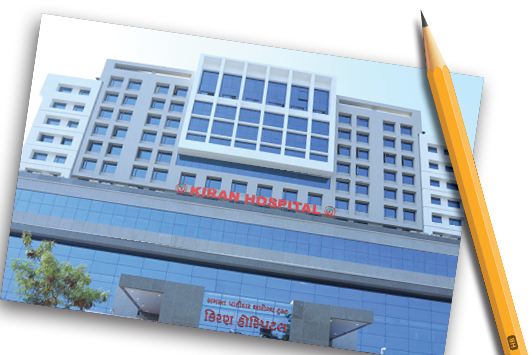
I arrive in Surat in the morning with a mission in mind: to understand what makes the city’s diamond industry tick. I’m therefore somewhat skeptical when my hosts insist I stop by the hospital, tearing me away from the diamond factories that have been wowing me with their scale and efficiency. Besides, I think to myself, hospitals make me queasy and are rarely a source of feel-good stories.
But as I step into the lobby of Kiran Hospital on the final leg of my whirlwind one-day visit to this Indian port city, Govindbhai Dholakia greets me with his familiar smile and a ceremonial bouquet of flowers. Dholakia — an industry elder statesman who established SRK Exports, and a co-founder of the hospital — immediately catches my interest as he gestures around the vast open space of the building’s entrance, beaming with pride.
“Everyone here is working with their hearts,” he tells me in broken English and with a compelling intimacy. “This project represents the heart of the diamond industry.”
Indeed, the hospital’s list of donors reads like a directory of the local trade, with some of the city’s textile businesses — Surat’s other main export — also contributing to the estimated $75 million it took to build and set up the facility.
It’s that collective participation that made this project possible, Dholakia stresses. It also put the hospital on a fast track to opening, which occurred just four years after Narendra Modi, then state minister of Gujarat, broke ground on the building. Fulfilling his promise to return when the project was complete, Modi — now prime minister — officially inaugurated the hospital in April.
And it has already made a difference, according to hospital director Dr. S. P. Shrivastav, who heads the oncology department. “Surat is very far behind in health care, and this hospital is making treatments available to tens of thousands of people who previously didn’t have access,” he says.
That includes specialty care in more than 30 fields, as well as an air ambulance service with a helipad, and a nursing school for basic and advanced care. Many of the facilities are also a first for Surat, such as the radiation oncology department, equipped with three linear accelerators and bunkers. Previously, cancer patients had to take the three-hour train ride to Mumbai for such treatment, Shrivastav notes.
From the beginning, the founders intended to make the most technologically advanced and affordable care available to people of all classes in Surat, Dholakia explains. “That’s why we needed everyone’s involvement,” he adds, pointing again to the numerous financial contributors.
The diamond industry’s role soon becomes apparent as we pass through the 13 upper and two basement levels, with each division and floor bearing the name of a different donor. The hospital’s name honors the largest of those, Kiran Gems, which contributed approximately $12 million to the project.
It’s a message that’s not lost on a group of industry executives who are with me on the tour. “I don’t think the industry markets its good deeds enough,” one of the executives says to me. “This really is a testament to the heart of Surat’s diamond community.”
As I leave the hospital, dreading my train ride back to Mumbai, it suddenly dawns on me: This may well be what makes Surat tick. Beyond its impressive diamond-cutting facilities and influence in the international industry, it’s the local trade’s hospitality and sense of community that truly enables it to make an impact. In that sense, I can’t help but feel good about this hospital.
ShutterstockArticle from the Rapaport Magazine - September 2017. To subscribe click here.